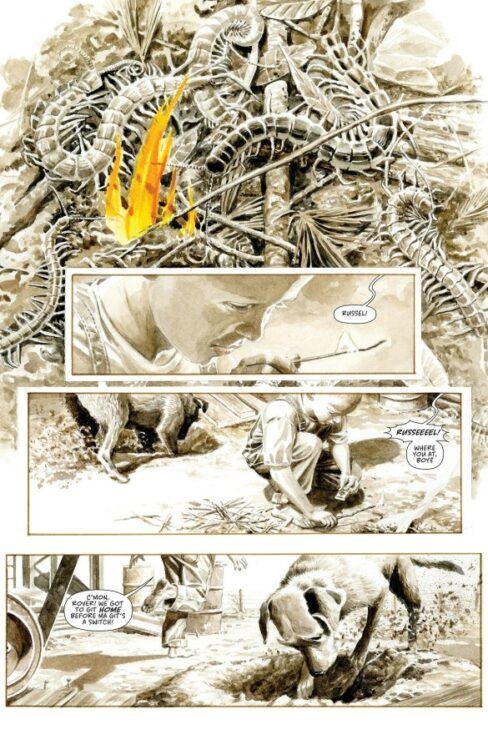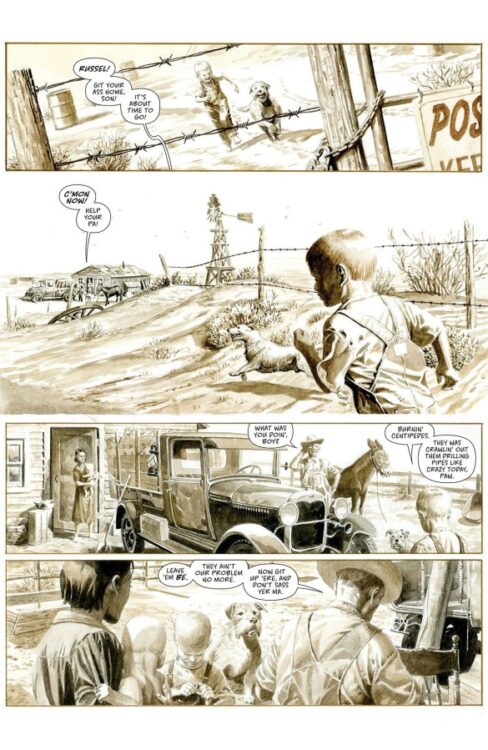From modern comics phenom J.G. Jones comes a Depression-era mystery with masterful art and writing in Dust To Dust #1. Co-written by Phil Bram, this opening chapter is a stellar work of historical fiction, with incredible visual work and impeccable scripting. A love-letter to both noir and the golden age of Hollywood, this is a must-read debut and one of the best opening chapters of 2024.
“In the darkest days of the Great Depression, death stalks the Dust Bowl. As towering dust storms blast the parched Oklahoma panhandle, farmers try to flee the failing town of New Hope, but no one gets far. Battling his own demons, Sheriff Meadows teams up with Sarah, a traveling photojournalist, in a desperate fight to stop a serial killer on the loose—the Death that rides the Dusters.”
Writing & Plot
J.G. Jones and Phil Bram pull from the annals of Great Depression-era novels and classic film for inspiration in Dust to Dust #1. The character-centric script is immensely compelling, immediately placing readers in the desperation of this historical era while only hinting at the mystery to come. Jones and Bram’s dialogue here is spectacularly good; naturalistic with a flare of old Hollywood. Every character has a different manner of speaking, from the Sheriff’s wizened delivery to the fiery confidence of Sarah the photojournalist. Every detail about the town and the struggles in every aspect of life are made clear in the dialogue writing without ever dipping into exposition. Every conversation feels important and memorable, from the Sheriff’s farewell to a family trying to escape poverty to his arguments with a corrupt city official. Each piece of the puzzle has a weight to it – and we haven’t even gotten to the murder part in this chapter. Jones and Bram are clearly taking their time in delivering this tale, as anything involving a murderer is almost completely absent save one recurring detail. By not rushing into the main plot, Dust to Dust is given time to breathe and establish its full list of characters, making it a compelling character story first before a murder mystery.
Art Direction
So much of Dust to Dust #1’s tone and pacing is due to J.G. Jones’ impeccable visual direction. His sepia pencils immediately place readers in the Oklahoma dust bowl of the 1930’s while channeling an aura of black and white Hollywood films. Jones’s direction feels reminiscent of a John Ford and Howard Hawks film, with his characters similarly drawing from the likes of Robert Mitchum and Lauren Bacall. His character animation here is a wonder in itself, with his detail looking as though they were stills from an old movie at times. The environmental art of the Oklahoma farm town, as well as the desolate land surrounding it, drive home this issue’s thematic core and conflict. Anyone who has read a J.G. Jones comic won’t be surprised at how stunning the visual work here is, but even so it may be some of the best in the artist’s career. Jones’s focus in this first chapter is building a cast of characters, and the sequential direction drives this home. Every sequence of interaction is expertly plotted and carefully paced to make sure each conversation – and observation – lands with memorable effect. The most effective bit in the comic, both visually and narratively, is the Sheriff occasionally pulling out and inspecting an “artifact” given to him in the book’s opening. Jones builds a sense of curiosity, then dread an unease, as the issue continues and it becomes readily apparent what the item actually is. The lettering (couldn’t find credits, unsure if it’s also by Jones or another talent) fits in beautifully with the rest of the visuals. The rough hand-drawn font conveys the dialogue’s tone, while the sand-worn SFX letters almost hide in the background as they craft diegetic noise. Overall, Dust to Dust is off to an incredible start in terms of visual direction.
Verdict
Dust to Dust #1 is a brilliant opening chapter to this murder-mystery story in the guise of a historical fiction comic. J.G. Jones and Phil Bram’s script is choke to the brim with sharp dialogue and carefully plotted storytelling, pulling influences from Dust Bowl-era literature and classic films. Jones’s visual direction is beyond stunning, capturing the humanity and tone of this story in a manner that makes every aspect of it immediately endearing to readers. Be sure to grab this outstanding debut issue when it hits shelves on December 26th!

